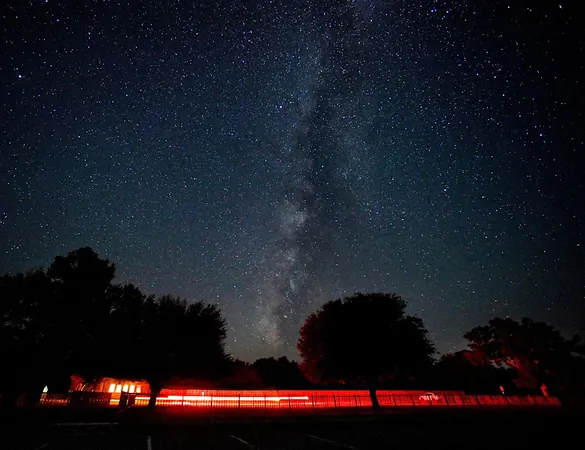
Don’t Miss the Milky Way: Your Ultimate Guide to Spotting the Galactic Center Before It's Too Late!
2025-09-18
Author: Olivia
Time is running out for stargazers! The breathtaking band of stars that make up our Milky Way's galactic center is visible — but only for a limited time as we transition into the chillier months.
Our vast galaxy is filled with billions upon billions of stars that shine brilliantly in the cosmos during specific times of the year. Unfortunately, as we approach the colder months in the United States, the opportunity to experience this celestial wonder draws to a close.
But don’t panic! If you're in the right spot at the right time, you could still catch a glimpse of that hazy band of light stretching across the night sky. All you need are your eyes, a dark sky, and a camera if you're into astrophotography!
What Exactly is the Milky Way?
The Milky Way is our home galaxy, a spiral marvel boasting a disc of stars that spans over 100,000 light-years. It appears as a rotating disc curving from a dense central region, and our planet resides on one of its spiral arms, about halfway to the center, according to NASA.
Why Is It Called the Milky Way?
The name 'Milky Way' originates from its faint, milky appearance across the sky — a sight that has entranced humanity for centuries!
When Is Milky Way Season?
Though the Milky Way is always visible, certain times are optimal for catching the stunning view. "Milky Way season" typically runs from February to October, with peak visibility in the Northern Hemisphere spanning from March to September.
Spotting the Galactic Center
The glorious core of the Milky Way becomes evident in June and usually remains visible every night through August, showcasing its brilliance higher in the night sky. However, as September unfolds, conditions remain favorable for viewing in many regions, particularly in the southern U.S.
From September to October, look for the Milky Way in the evening sky. Early in the night, its core will rise at a steep angle, gradually flattening as it moves across the sky.
Perfect Timing with the New Moon
Get ready for stellar viewing! A new moon phase on September 21 means less light competition for the Milky Way, making the second-to-last week of September prime time for watching this awe-inspiring sight. As darkness falls, expect a glowing arc of the Milky Way stretching majestically from northeast to southwest.
Tips for Observing the Milky Way
To enhance your Milky Way spotting experience, search for the Summer Triangle — a formation of three bright stars that shine across the Milky Way. In the Northern Hemisphere, it rises in the southeast, arcs across the sky, and sets in the southwest.
For the best views, find a location free from cloud cover and city lights. Use resources like DarkSky International to locate dark sky communities near you. With 163 designated locations in the U.S., the perfect stargazing destination is closer than you think!
So grab your friends and head out under the stars! The Milky Way's brilliance is just waiting to be admired.









 Brasil (PT)
Brasil (PT)
 Canada (EN)
Canada (EN)
 Chile (ES)
Chile (ES)
 Česko (CS)
Česko (CS)
 대한민국 (KO)
대한민국 (KO)
 España (ES)
España (ES)
 France (FR)
France (FR)
 Hong Kong (EN)
Hong Kong (EN)
 Italia (IT)
Italia (IT)
 日本 (JA)
日本 (JA)
 Magyarország (HU)
Magyarország (HU)
 Norge (NO)
Norge (NO)
 Polska (PL)
Polska (PL)
 Schweiz (DE)
Schweiz (DE)
 Singapore (EN)
Singapore (EN)
 Sverige (SV)
Sverige (SV)
 Suomi (FI)
Suomi (FI)
 Türkiye (TR)
Türkiye (TR)
 الإمارات العربية المتحدة (AR)
الإمارات العربية المتحدة (AR)